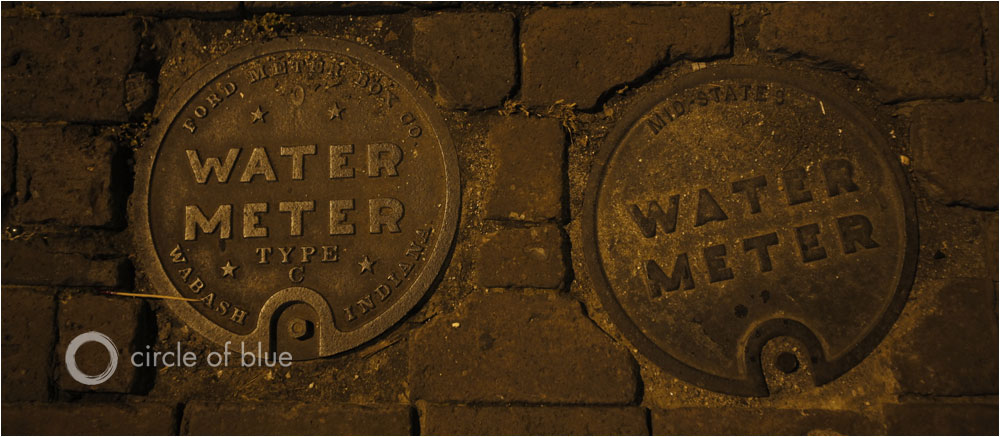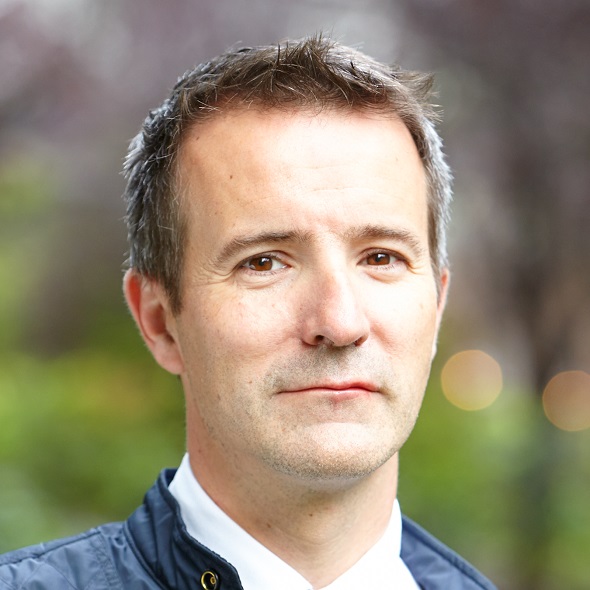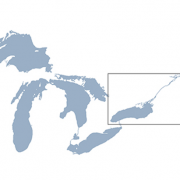WaterSmart Pulls Water Savings from the Cloud
Software company uses data to reboot the venerable water utility.
By Brett Walton
Circle of Blue
Ideas flow for Robin Gilthorpe, a self-described “outdoor cat”, when he leaves the air-conditioned boxes of modern life.
A few years ago the veteran of the information technology industry biked west out of Denver, retracing the route of an earlier ride, when he noticed the drought-scorched landscape around one of America’s fastest growing cities. Gilthorpe, with 25 years experience at data analysis firms, thought he could bring a new approach to the West’s longstanding water problems.
“This is not getting better,” he remembers thinking. “Who is doing something? I need to do something.”
Hired in August 2014 as CEO of WaterSmart Software, a five-year-old San Francisco company that uses utility data to prod households to save water, Gilthorpe now has that opportunity.
–Robin Gilthorpe, CEO WaterSmart Software
Gilthorpe’s job straddles boundaries. He bridges the world of the municipal utility — an institution that flourished in the United States in the 20th century by building city-spanning networks of pipes and treatment plants that deliver clean water — with the world of information technology, a 21st century construction that connects computers and data centers (collectively known as the “cloud”) by channeling digital bits, not water.
WaterSmart is one of a small band of IT companies — along with Israel’s TaKaDu — that hope to improve a water utility’s performance by strengthening its brain. WaterSmart pairs data collected by water utilities with weather forecasts and information on family size and lot size to provide tailored reports on water use by household. The software generates monthly report cards that are sent to families and compare their water use to their neighbors’. Households using less water than average get a smiley face on their report card; those using more are punished with a frown. Water savings for utilities using the software are consistently five percent or higher, Gilthorpe said.
“There’s good psychology behind it,” said Abby Figueroa, spokeswoman for East Bay Municipal Utility District, one of WaterSmart’s clients. “Keeping up with the Joneses certainly applies for water use.”
Gilthorpe is an anomaly in the water world. He speaks in the wonky lingo of a business manager — “I like to go deep in a particular vertical” — and rubs shoulders with the stars of venture capital. His friend Steve Westly, one of eBay’s early executives and a former board member at Tesla Motors, introduced Gilthorpe to WaterSmart. But he also speaks with the acuity of a clear-eyed scout who is set on pulling the venerable water utility, bit by bit, into a new era.
“Utilities have data, not information,” Gilthorpe told Circle of Blue, in an interview at the One Water Leadership Summit, in San Francisco. “They don’t have the capability to put the data together into a picture. We help develop the picture.”
Data-Driven Conservation
For U.S. water utilities, the picture, broadly speaking, is faded. Industrial cities in the Northeast and Rust Belt have water mains that were put into the ground 80 years ago, on average. Water main breaks are a frequent and disruptive occurrence. Cities that lose less than 10 percent of their water supply to pipe leaks are considered high achievers.
WaterSmart hopes to change that, and numbers are the core of the business. Gilthorpe said that the company crunches 760 million data points per hour, a gusher that will grow as the company does.
Utilities generate reams of data through their meter readings, but most of it sits on the shelf because utilities lack the technical capacity to analyze the numbers. That is where WaterSmart’s software helps. The IT solution has several advantages. First, it spots patterns, with comparisons of household water use a primary target. But other products are available beyond the monthly report card. When paired with weather data, WaterSmart can send notices to homeowners to turn off irrigation systems before a storm approaches.
Second, the software can analyze conservation claims. Does installing low-flow showerheads lead to real water savings? Or do people counteract the lower flows by taking longer showers?
“We can look at the slippage between the deemed efficiency savings and the actual savings,” Gilthorpe explained, claiming that the analysis has changed how some of the company’s clients invest in conservation. He would not, however, disclose names.
Combined, all these changes save water and money. Treatment plants and water pipes, for example, are designed to meet peak demands, which often occur on the hottest days in summer. Reducing the size of the peaks reduces the cost of designing, building, and operating a water system. Delivering less water means lower operating costs, for chemicals and energy.
“If utilities are going to spend millions, they owe it to their customers to spend it well,” Gilthorpe said.
More fundamental changes will come as WaterSmart latches on to the growth in smart meters and smart appliances, Gilthorpe said. Smart devices are connected to the internet and are a natural part of the IT-water connection. Instead of notifying a homeowner to turn off the sprinklers, a smart system could do that automatically, with the owner’s consent.
Another example: sewage overflows are a problem for cities with sewers that transport both rainwater and household waste in the same pipe to treatment plants. By tracking the wastewater system’s flow and the approach of a thunderstorm, WaterSmart could tell households to wait several hours to run the dishwasher or washing machine, to prevent exceeding the system’s treatment capacity.
Utilities are beginning to embrace this approach. WaterSmart’s revenue tripled last year, Gilthorpe said. The company started 2014 with 12 contracts, and now it is working with 47 utilities, from coast to coast, in wet states and dry states. Three-quarters are in California, which should not be surprising given the state’s drought emergency and its fondness for the tech industry.
East Bay Municipal Utility District, which serves 1.3 million people on the east side of San Francisco Bay, signed a three-year contract with WaterSmart in June 2014. During a one-year trial run that ended in 2013, some 10,000 homes in Castro Valley reduced water use by five percent. With relatively homogenous lots and residences, the town was an ideal site for running an experiment. The results impressed the utility’s leaders.
“It was such a low-cost, efficient way of getting savings that the staff and board recommended that we expand the program,” Figueroa told Circle of Blue. The reports cost between $US 8 and $US 10 per customer per year, compared to $US 50 for a toilet rebate and $US 2,500 to replace a grassy lawn with dry-climate landscaping, which both require staff time to administer, Figueroa said.
East Bay signed up 50,000 households for the reports in the first year of the contract and will have 100,000 by year 3.
For WaterSmart, the next leap will be overseas. The company raised $US 7 million in funding in March, which Gilthorpe said would more than sustain the business through its international launch. Its assessment of the world’s water problem should serve it well throughout the expansion.
“Our core thesis is this,” Gilthorpe explained. “This is not a drought problem; this is a growth problem.”
That problem is as visible in Mumbai and Shenzhen as it is in the crispy hills outside of Denver.
Brett writes about agriculture, energy, infrastructure, and the politics and economics of water in the United States. He also writes the Federal Water Tap, Circle of Blue’s weekly digest of U.S. government water news. He is the winner of two Society of Environmental Journalists reporting awards, one of the top honors in American environmental journalism: first place for explanatory reporting for a series on septic system pollution in the United States(2016) and third place for beat reporting in a small market (2014). He received the Sierra Club’s Distinguished Service Award in 2018. Brett lives in Seattle, where he hikes the mountains and bakes pies. Contact Brett Walton











Leave a Reply
Want to join the discussion?Feel free to contribute!